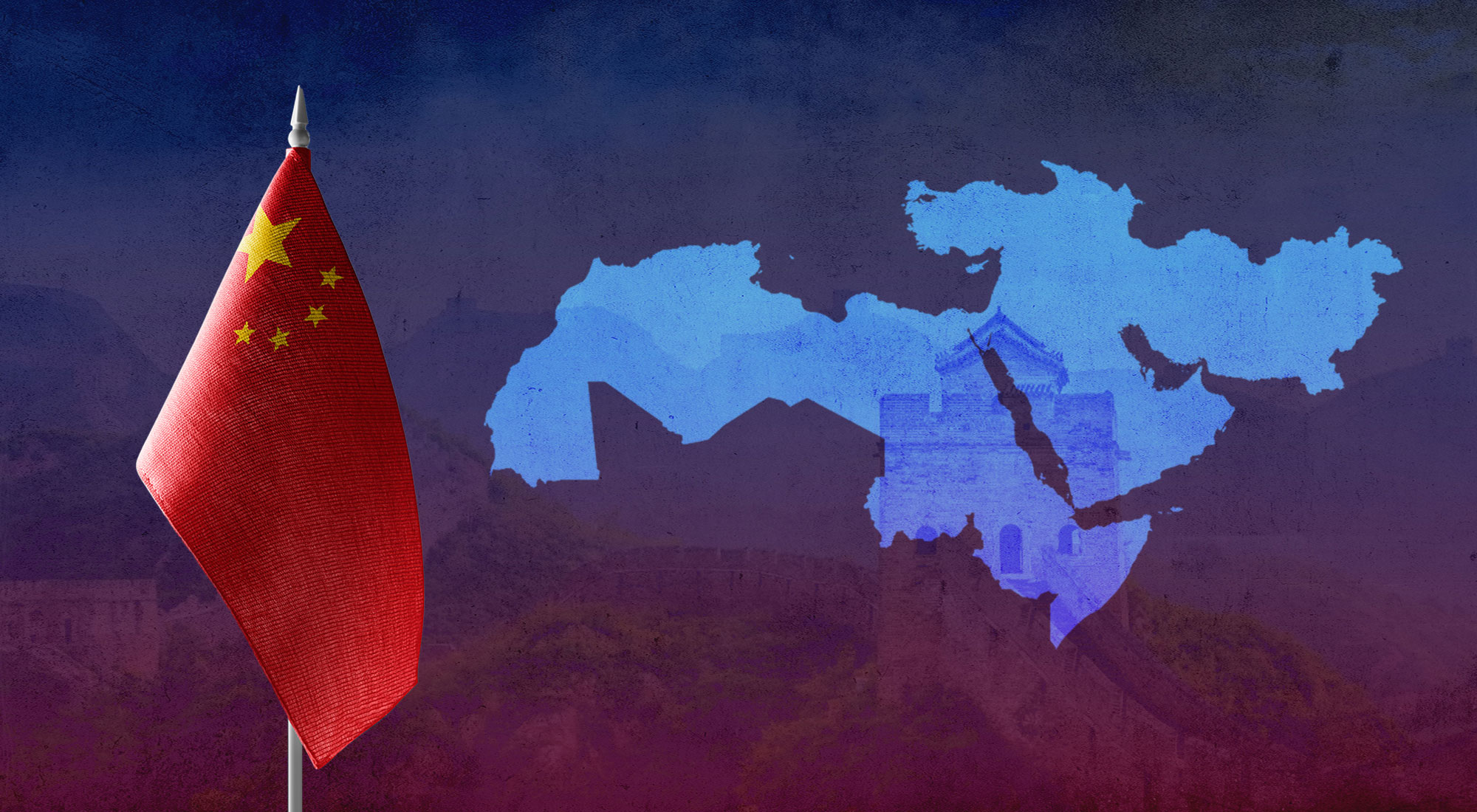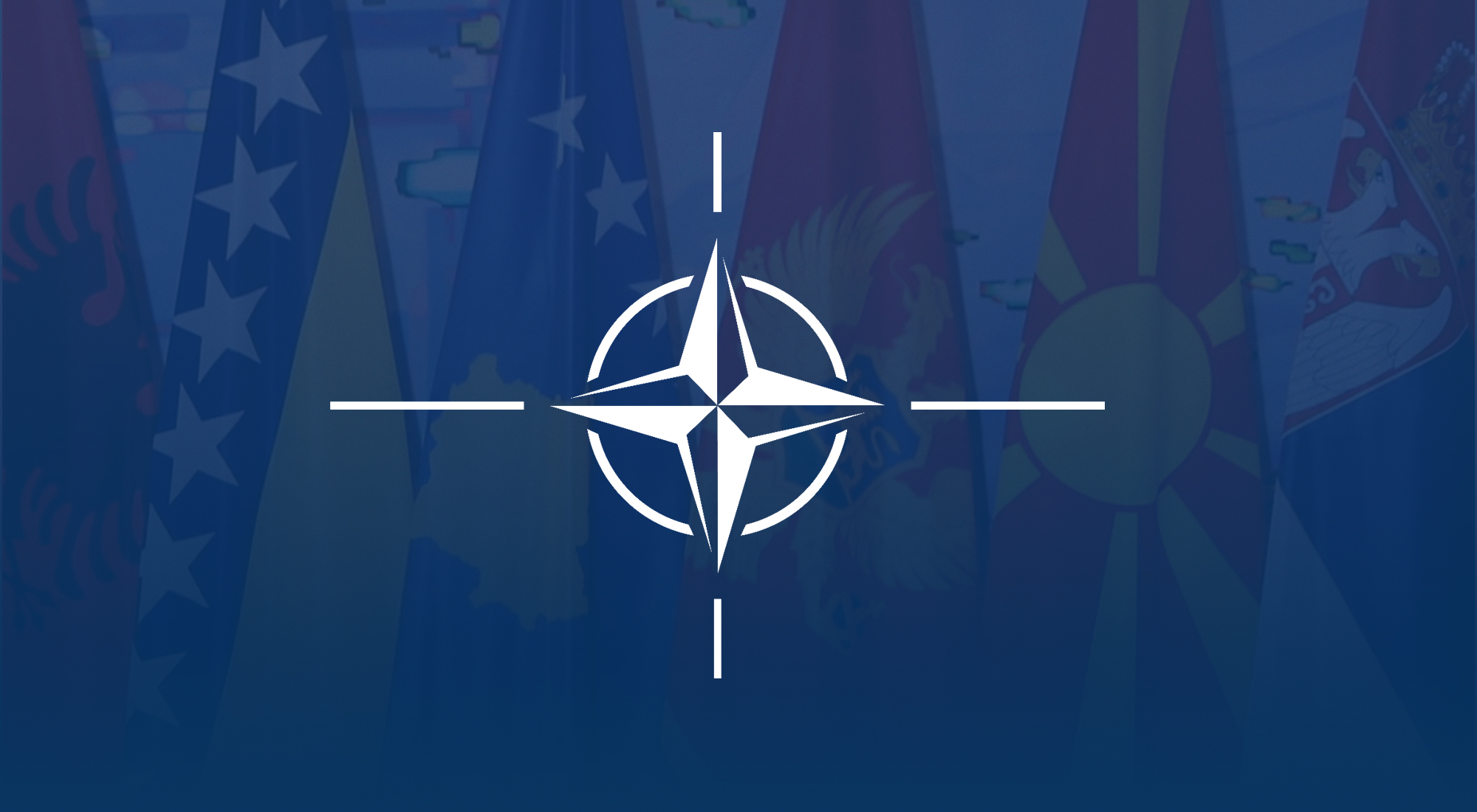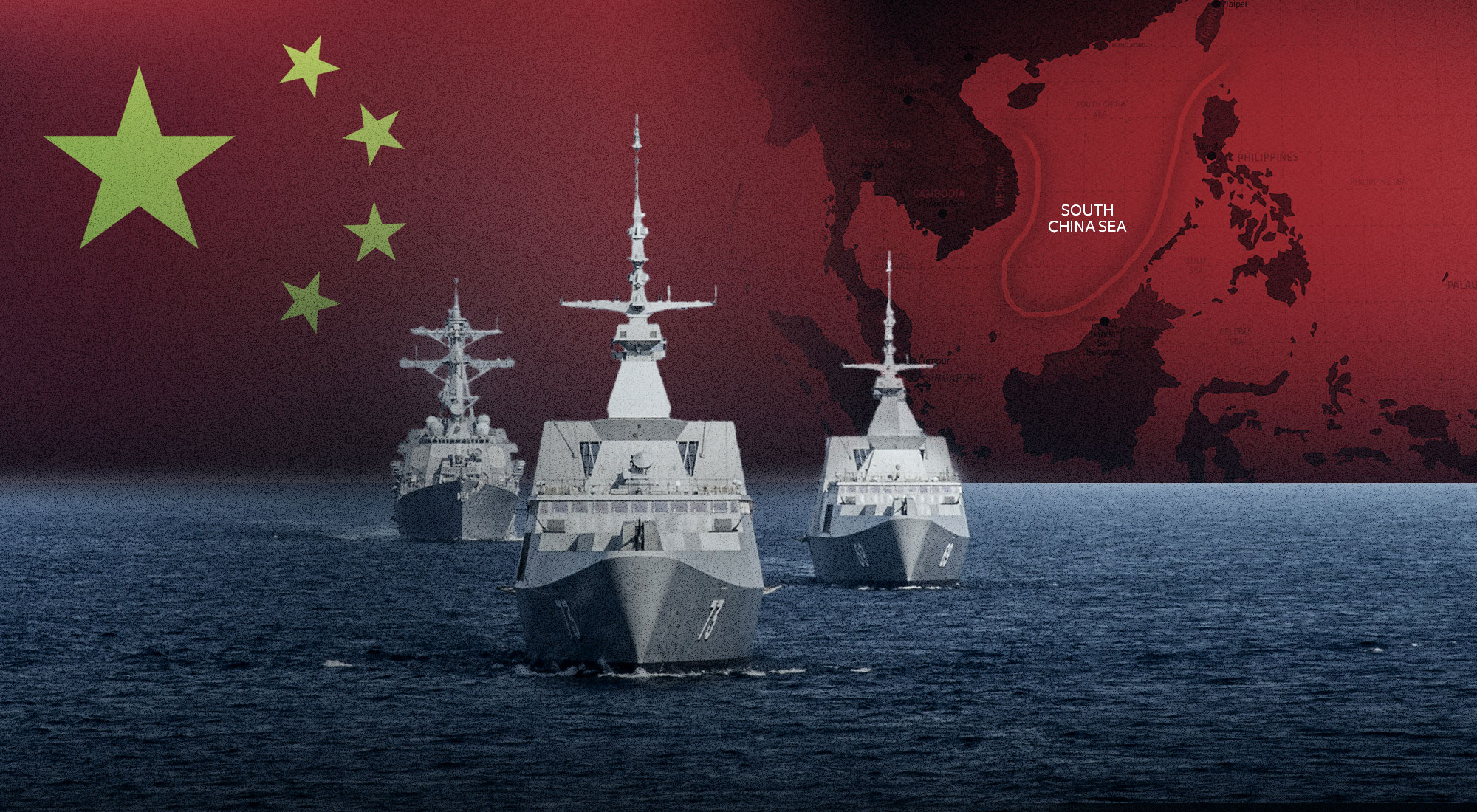The past several months have seen a tangible shift in the nature of the triangle that exists between the U.S., China and MENA (particularly key GCC) states. Since China’s engagement in the Middle East began to take off following the onset of the Belt and Road Initiative (BRI) in 2013, with China-MENA relations henceforth diversifying far past the trade in hydrocarbons that had almost solely defined their historical relations, the U.S. had largely let China’s engagement proceed without complication. This began to change in 2018, when the U.S. began its campaign to push its partners worldwide to reject Huawei technology in their ICT infrastructure. Prior to the past several months, the most dynamic manifestation of this U.S. pushback against Chinese influence in MENA had been the stalled F-35 sale process to the UAE due to U.S. concerns that Huawei technology in local ICT infrastructure exposed this most sensitive of American military technology to Chinese surveillance risks. However, this instance didn’t pose an explicit challenge to the prospects of China’s technology relationship with the UAE in a sector-wide capacity.
The past ten months, however, have begun to see the U.S. pushing back against Chinese engagement in the Middle East at a more systemic level. August last year saw the U.S. curb Nvidia semiconductor exports to Gulf states as a result of concerns that increasingly close ties between these Gulf states and China would see the latter gain access to these chips (something that had already been prohibited through U.S. semiconductor export bans to China—a primary feature of America’s escalation of its strategic competition with China).[1] February this year saw the announcement that the Gulf’s leading AI and technology company, G42, would be divesting from Chinese entities,[2] followed up in April with the major revelation that Microsoft will be investing $1.5 billion in G42 as an initial step in building an expanding major strategic partnership with the company.[3]
Given these developments, the tenth biennial meeting, at the ministerial level, of the China Arab States Cooperation Forum (CASCF) in Beijing at the end of May this year gained particular significance regarding what it might illustrate concerning China’s approach to the region in light of the increasing complexities certain key China-MENA state relations now face due to U.S. pushback.
Formed in 2004, the CASCF is the peak body of multilateral cooperation and policy coordination between China and all the twenty-two states of the Arab League. The foreign ministers of all the parties meet at the Forum biennially to delineate the policy priorities for the coming two years, with these meetings playing a key role in shaping the nature of China-MENA relations for the upcoming period. For instance, the 2014 forum saw the rollout of the 1+2+3 cooperation framework (1 = hydrocarbons, 2 = trade & investment and infrastructure construction, and 3 = nuclear energy, space satellites, and renewables) that would guide the focuses of the BRI in the Arab World into the future and indeed generated subsequent results behind these pillars.[4] The 2018 forum saw China make a headline-grabbing pledge of $23 billion in loans, investment and aid, a development that turned heads in the West.[5] Fast forward two years, and the 2020 forum concluded in cooperation agreements in technology sharing, energy security, green innovation, and infrastructure development. And the 2022 forum meeting then elevated the focus of renewable energy, tourism, and automotives in the relationship.[6]
Further significance has been added to CASCF meetings since 2022, when it was agreed that the forums would from then on be accompanied by heads of state visits. These state visits are also buttressed by a number of key ministerial meetings and delegations that occur in the immediately surrounding period of the forum. On top of these state and ministerial meetings, the weeks surrounding the CASCF have historically also been a time when numerous commercial deals in priority sectors are unveiled—something that gives extra energy to the policy priorities that are delineated at the forum. Accordingly, in order to get a read on the nature of China-MENA relations for the short-medium term, the CASCF is a useful place to start.
This piece will proceed by first examining the results of the 2024 forum—especially in relation to previous forums—and the peripheral China-Arab state engagements and agreements that occurred surrounding it. While more than three months have passed since the forum, the renewed formalized ‘strategic partnership’ formation focus that was overtly driven by this year’s forum saw another burst of energy the past week with the establishment of a China-Libya strategic partnership.[7] Accordingly, this piece will first propose some themes and trends in an attempt to define the nature of the results from the forum and its recent aftermath. Secondly, these trends will be considered alongside the broader context and developments regarding China-MENA ties in order to suggest potentially defining features for the foreseeable future of the relations.
Parsing the 2024 CASCF and its peripheral engagements
Theme 1: A number of bilateral diplomatic agreements that were (mostly) tokenistic
Aside from a collective statement on the Gaza crisis that didn’t portend any tangible action,[8] there was a distinct lack of joint China-Arab state regional-level announcements or initiatives introduced at the 2024 forum. This was in contrast to the various examples of such announcements and initiatives unveiled in previous forums, discussed above. Instead, a number of bilateral diplomatic agreements were unveiled, with three Arab states joining the long list of other Arab states holding formalized partnership status with China.
China’s formalized partnerships framework is a nuanced and flexible diplomatic tool that Beijing uses to manage its international relations. This framework includes various levels of partnerships, each reflecting the depth and nature of China’s engagement with different countries. The type of partnership established with a country has historically delineated the potential with which China views the relationship, and guides the subsequent nature, depth and diversity of the relation.[9] In the MENA region, China’s partnerships can be roughly sorted across three tiers,[10] as shown in the below table.
| China’s formalized ‘partnerships’ with MENA countries prior to 2024 CASCF | |||
| Country | Partnership Type | Tier of partnership | Year Established |
| Algeria | Comprehensive Strategic Partnership | 1 | 2014 |
| Egypt | Comprehensive Strategic Partnership | 1 | 2014 |
| Saudi Arabia | Comprehensive Strategic Partnership | 1 | 2016 |
| Iran | Comprehensive Strategic Partnership | 1 | 2016 |
| UAE | Comprehensive Strategic Partnership | 1 | 2018 |
| Turkey | Strategic Cooperation Relationship | 2 | 2010 |
| Israel | Innovative Comprehensive Partnership | 2 | 2017 |
| Sudan | Strategic Partnership | 3 | 2014 |
| Iraq | Strategic Partnership | 3 | 2015 |
| Morocco | Strategic Partnership | 3 | 2016 |
| Qatar | Strategic Partnership | 3 | 2014 |
| Jordan | Strategic Partnership | 3 | 2015 |
| Djibouti | Strategic Partnership | 3 | 2017 |
| Kuwait | Strategic Partnership | 3 | 2018 |
| Oman | Strategic Partnership | 3 | 2018 |
As shown, immediately prior to the 2024 CASCF there had been no new formalized partnerships formed since 2018, and the only MENA states still missing from this list were Tunisia, Syria, Bahrain, Somalia, Palestine, Mauritania, Yemen, and Libya. The 2024 CASCF was interesting in this regard, as it broke the six-year hiatus of formalized partnership formation between China and MENA states, and added Bahrain (Comprehensive Strategic Partnership), Syria (Strategic Partnership), and Tunisia (Strategic Partnership) to the list. As mentioned above, Libya (Strategic Partnership) was added to the list last week.
What can we read into these three new partnerships? Given the delay in these partnership formalizations relative to the previous ones and given the fact that the small number of remaining MENA countries without a formalized partnership are countries (Somalia, Palestine, Mauritania, and Yemen) who, aside from Mauritania, are systemically challenged by instability or holding negligible potential for Chinese economic interests, these latest three partnership formalizations should hardly be viewed as particularly noteworthy or heralding notable future developments.
This is further confirmed when you consider each of the three new partnership formalizations individually. There are minimal factors spurring substantial growth in the China-Bahrain relationship given the combination of Bahrain’s small market size and existing alliance with the U.S. In terms of Syria, it remains too unstable for notable Chinese investment.[11] Libya is hardly different—the current turmoil regarding its central bank, and the signs of a renewal of open conflict between the east and west blocs in the country are hardly grounds for Chinese investment to return to the country, even if there have been Chinese business delegations to the country of late.[12] Regarding Tunisia, its strategic location on the doorstep of the European market is an asset, but China has already made substantial progress in developing its industrial presence in Egypt, and increasingly so in Algeria and Morocco, in order to exploit their similar strategic locations vis-à-vis Europe, and these three latter countries represent far greater domestic markets and geostrategic assets for China. Accordingly, Tunisia’s value for China is relatively minimal.
Essentially, these partnership formalizations announced at and since the 2024 CASCF give the impression of a relatively surface-level effort (particularly regarding the “comprehensive” delineation of the Bahrain partnership) to generate some PR momentum behind China-Arab state relations in a year in which those relations have faced quite public bumps in the road. Similarly, the partnership formalization with Syria (which occurred, not coincidentally, in the first CASCF following Syria’s readmission to the Arab League in 2023 and increasing normalization with the Arab world) gives Beijing an opportunity to inject some further momentum behind the narrative of China being the reconstruction leader of the war-torn country, a narrative that Beijing has nurtured over the past eight years or so[13] without making material contributions.
Outside of these partnership formalizations, the UAE and China signed a bilateral agreement stipulating a readiness to exchange experience in the defense and security domain.[14] Given China has already sold training jets and military drones to the UAE, and both countries have conducted joint air force drills, there isn’t substantial room for this mandate of exchanging experience to signify anything particularly new.
This UAE-China agreement was more than what was produced during Saudi Finance Minister Mohammed Al-Jadaan’s trip to Beijing immediately preceding the Forum. Accompanied by an array of officials from the Saudi central bank as well as infrastructure and development-related departments, Minister Al-Jadaan met with the Chinese Finance Minister, Lan Fuan, as well as Vice Premier He Lifeng under the framework of the Finance Subcommittee of the High-Level China-Saudi Joint Committee (HLJC).[15] The HLJC is the guiding mechanism for the bilateral relationship, and when it convenes, the result has historically been numerous multi-billion dollar contracts and/or MoUs.[16] However, at the May 2024 meeting, these MoUs and contracts were conspicuously absent.
The Saudi Defense Minister Prince Khalid bin Salman also held high-level meetings with his Chinese counterparts, but this time in late June.[17] The discussions focused on army exchanges, personnel training, and joint military exercises, but didn’t produce any concrete agreements or tangible developments. However, this was not likely the point of the meetings. Saudi Arabia is in the midst of major negotiations with the U.S. for a groundbreaking defense treaty that would constitute a diverse security package far beyond anything China could or would want to offer.[18] Accordingly, the Defense Minister’s trip to Beijing can likely be understood more as a bargaining tactic to try and achieve more favorable terms in Riyadh’s ongoing negotiations with Washington—for instance, pushing the U.S. to overturn the ban it imposed on offensive weapons sales to Saudi Arabia three years ago—as opposed to any notable development in the Saudi-Chinese defense relationship.
Tangible developments in the Saudi-Sino relationship did eventually emerge in July, however, when the Governor of Saudi Arabia’s Public Investment Fund (PIF) led an extensive delegation to Beijing that saw three of China’s largest renewables manufacturing companies sign joint ventures with PIF to construct solar and wind power component plants in Saudi Arabia.[19] At the beginning of August, it was announced that partnerships had been established between PIF and six leading Chinese financial institutions (Agricultural Bank of China, Bank of China, China Construction Bank, China Export and Credit Insurance Corporation, Export-Import Bank of China, and Industrial and Commercial Bank of China) that will facilitate “two-way capital flows between the countries through both debt and equity” to the value of $50 billion.[20] The “debt and equity” dimension here could mean, for example, PIF and the Chinese institutions issuing Riyal- or RMB-denominated bonds that the other could purchase, thus increasing reserves of each other’s currency and simplifying investment processes in Saudi or Chinese (or even joint) projects or entities.
The fact that these notable Sino-Saudi deals didn’t emerge during May immediately in and around the occurrence of the CASCF could be an illustration of Riyadh’s perception that May was not particularly tactful timing to seal such deals. The month of May came right off the back of the particularly high-profile American undercutting of Chinese technology ties in the UAE and was also in the thick of the U.S.-Saudi defense pact negotiations (negotiations that seem to have since died down).
The China-Egypt bilateral relationship also saw a form of development on the peripheries of the forum. President Abdel Fattah El-Sisi’s state visit to Beijing to coincide with the CASCF saw the announcement of Sino-Egyptian ties in 2024 officially being titled the “Egypt-China Year of Partnership.”[21] Sino-Egyptian investment and commercial ties were already extensive—for instance, China has been the main constructor of Egypt’s vast new administrative capital city, the leading foreign source of the Suez Special Economic Zone’s industrialization, and the main developer of Egypt’s ports—so this announcement does not herald much of a quantitative change in the relationship. It may well be geared to give momentum to a qualitative change, or addition, in the economic relations though: discussions between China and Egypt on the sidelines of President Xi Jinping and President El-Sisi’s meeting emphasized the importance of focusing on Chinese technology transfer and capacity building within Egypt.[22] This seemed to be tied to the recent China-Egypt electric vehicle (EV) deals that were signed just before the 2024 CASCF, whose details and implications are discussed below.
Theme 2: Key Chinese strategic economic and industrial policy goals furthered through new commercial deals
In the days and weeks immediately following the 2024 Forum, a number of significant deals were signed between Chinese and MENA governments or companies in the priority economic sectors (electric vehicles, lithium batteries, photovoltaics, and oil and gas) vis-à-vis China’s economic strategy for the region. These key elements pertain to, firstly, securing China’s domestic energy security through extensive upstream investments, and, secondly, offshoring Chinese industrial capacity in the electric vehicle (EV) and photovoltaic (PV) sectors to conducive MENA markets in order to capitalize both on the conduciveness of those markets as well as enabling Chinese firms to bypass EU tariffs and export to the European market.
Regarding the EV industry, Chinese firm Chijet Motor Company, Inc. announced in June that one of its subsidiaries would be partnering with Algerian firm SARL AI MOTORS, whereby the latter would distribute Chijet’s cars (which include both traditional fuel cars and EVs).[23] Preceding this deal were multiple similar deals in Egypt. Chinese auto firm Faw Group signed a joint venture with Egypt’s GV Auto in May that will see the partnership produce and distribute EVs across Egypt, and export them onwards.[24] Before this came a deal in April by smart, a Chinese-German EV company, with Egypt’s Ezz Elarab Group to enable mass distribution of the brand’s cars across Egypt.[25] This in turn had been preceded by a similar distribution deal between China’s XPENG and Egypt’s RAYA Group in February.
These EV partnerships feed into developments like Chinese firm CNGR Advanced Material Co. entering into a partnership in September last year with African private investment fund Al Mada to establish an EV battery production base in Morocco, with all the batteries to be produced planned for export to Europe.[26] Then in August this year, China’s BTR New Material Group signed on to build its second plant in Morocco to produce EV battery components.[27] This Moroccan basing would enable both Chinese companies’ batteries and battery components to be able to be exported to the EU market without being subjected to tariffs in the not unlikely event that the EU introduces steep tariffs on Chinese lithium batteries in the same manner as it has just done for Chinese EVs. Aside from the strategic benefit of enabling the circumvention of EU tariffs, Morocco also holds rich phosphate resources, which are key to battery production. The European battery production industry is currently years beyond the Chinese—as an executive at Volkswagen’s battery unit said, “We don’t have any supply chain”—so China’s strategic moves in Morocco, compounded by Chinese firms’ ability to produce batteries at half the average global cost,[28] are set to enable Chinese EVs and EV batteries to hold great sway in the European market.
In terms of the PV industry, Chinese PV manufacturer Hainan Drinda New Energy Technology Co. signed on in June to build Oman’s first solar cell factory, with solar cell production in Oman looking set to expand rapidly given the country’s ambitious solar plant plans that include five new plants by 2029 alone (with more being likely due to Oman’s green hydrogen ambitions, which will need to be powered by renewables).[29] Additionally, China’s Trina Solar, one of the world’s largest PV producers, partnered with an Egyptian company in May to enable a steep increase in the distribution of Trina Solar’s solar cells across Egypt, with expectations of Trina being able to capture 30% market share in the country.[30] More recently, China Energy Engineering Corporation signed a $976 million contract in August 2024 to construct a 2000-megawatt solar plant in Makkah province.[31]
China’s oil and gas interests also saw notable progress in the period surrounding the 2024 CASCF. In May, Chinese companies won bids for oil and gas exploration licenses for 10 different oil and gas fields in Iraq, the only foreign country to win bids in this latest licensing round by Iraq.[32] Additionally, China’s Sinopec signed an MoU with Algeria’s state oil and gas firm Sonatrach in June to push for increased exploration.[33] This was followed in September by China Petroleum Engineering & Construction Company securing two deals, one to revamp Algeria’s Alrar gas field and the other to construct the final two parts (the extensive Habshan to Fujairah stretch) of the UAE’s West-East pipeline project.[34]
Likely trajectories, and their implications
Given the GCC is China’s preeminent focus in its Arab world relations,[35] the escalating U.S. pushback against numerous elements of China’s engagement in the Gulf that has defined the past year has led to an environment in which major, substantive, diplomatic agreements between China and these key GCC states are unlikely. As is seemingly illustrated by the mostly surface-level (compared to previous CASCF meetings) diplomatic engagements between both sides in and around the 2024 forum, Gulf-China relations seem to be in a period of feeling out the situation vis-à-vis the U.S.-Middle East-China triangle and seeing what is possible and expedient in the increasingly complex climate as of late.
Accordingly, the sweeping regional arrangements that we tended to see in China-MENA relations following the onset of the BRI will likely decline for the foreseeable future, as without the involvement of the UAE and Saudi Arabia there would be no point behind any such regional frameworks. Given the increasing role of the U.S. in key China-GCC relationships, it would be surprising if China’s Global Development Initiative (GDI), Global Civilization Initiative (GCI), and Global Security Initiative (GSI)—China’s new strategy to reshape global governance in its favor by offering an alternative vision focused (particularly across the Global South) on promoting state sovereignty, non-interference, economic progress over democracy, and collective, as opposed to individual, rights[36]—received substantive traction at the diplomatic level from these key GCC states for the short-term future.
This period of China and leading GCC states feeling out the situation in their bilateral relationships, especially vis-à-vis the extent of U.S. resistance, is likely to lead to what may appear on the surface as somewhat vacillatory or contradictory movements from these GCC states regarding their China or U.S. alignments. The first illustration of this seems to be the example raised above regarding high-profile Sino-Saudi meetings during May-June producing unusually unsubstantial results, followed by notable tangible developments being produced in the later months once the timing was less inflammatory vis-à-vis Washington. A further key example of this trend has been Alat, a subsidiary of Saudi Arabia’s Public Investment Fund, publicly emphasizing its willingness to divest from China if asked by the U.S., followed up just a few weeks later by Alat and China’s computer manufacturer Lenovo then announcing a strategic collaboration and investment agreement.[37] Then in June, Saudi Aramco subsidiary Prosperity7 Ventures participated in a financing round for Chinese AI firm Zhipu AI in the midst of the well-storied U.S.-Saudi defense pact negotiations (in which the U.S. had apparently told Saudi Arabia it should decouple its technology ties with China) nearing a close.[38] Off the back of all this, in September we saw Huawei announce it will further bolster Saudi Arabia’s AI capacity through increasing Huawei cloud computing and data storage capacity services and infrastructure in the country.[39] Taken together, these examples illustrate how the lay of the land is still seemingly being established in many respects regarding where Saudi Arabia falls within the U.S. technology containment campaign on China.
Looking outside of Saudi Arabia and the UAE, however, the next two leading states of Chinese focus, Egypt and Iraq,[40] are likely to present a different case regarding diplomatic agreements, as U.S. pushback regarding China is far less acute a dynamic for those governments. Egypt already signed on to the GDI in July 2023,[41] and President El-Sisi’s meeting with President Xi at the 2024 Forum saw El-Sisi extoll the virtues of the GDI, GCI and GSI, emphasizing Egypt’s readiness to cooperate with China on the initiatives.[42] Iraq has yet to formally align with any of the initiatives, but the rising level of attraction that a notable portion of the Iraqi political elite has been shown to hold over the past couple of years regarding the Chinese development experience and governance lessons would suggest that the GDI, GCI and the GSI are unlikely to face significant barriers in gaining diplomatic support from Baghdad.[43] This is especially so seeing as Iraq has been pushing for China to play a key role in the establishment of Iraq’s ‘Development Road’, which is aimed to connect Al Faw Port on Iraq’s south coast to Turkey through an infrastructure network.[44]
While there were no grand regional economic frameworks or agreements unveiled at the 2024 forum like there were at previous CASCF meetings, Chinese EV and energy sector expansion across the region has continued unabated nonetheless. As certain pivotal Middle Eastern states work out how to navigate the increasingly fine line they need to walk vis-à-vis their engagement with China now that the U.S. is more actively pushing back, Chinese focus on EVs, PVs, and lithium batteries will continue to expand to accompany the traditional oil and gas attention. Looking ahead then, while transnational Chinese diplomatic frameworks face a more complicated path in certain parts of MENA than they did previously, Chinese progress in its target economic sectors will largely continue at pace.
[1] Nellis, Stephen and Max A. Cherney, “US Restricts Exports of Some Nvidia Chips to Middle East Countries: Filing,” Reuters, August 31, 2023, https://www.reuters.com/technology/us-restricts-exports-some-nvidia-chips-middle-east-countries-filing-2023-08-30/.
[2] Cabral, Alvin R, “Why the UAE Must Perform a Diplomatic Balancing Act to Achieve Its Global AI Ambitions,” The National, February 15, 2024, https://www.thenationalnews.com/business/technology/2024/02/15/why-the-uae-must-perform-a-diplomatic-balancing-act-to-achieve-its-global-ai-ambitions/.
[3] Dutton, Jack, “With China rivalry in mind, UAE’s Sheikh Tahnoon hits tech reset in US visit,” Al-Monitor, June 19, 2024, https://www.al-monitor.com/originals/2024/06/china-rivalry-mind-uaes-sheikh-tahnoon-hits-tech-reset-us-visit.
[4] Shen, Shiwei, “BRI Projects & Programs: China-Arab states ‘1+2+3’ cooperation pattern,” CGTN, December 8, 2022, https://news.cgtn.com/news/2022-12-08/BRI-Projects-Programs-China-Arab-states-1-2-3-cooperation-pattern-1fAE45LdebS/index.html.
[5] “China boosts US$23 billion in loans and aid to Arab states as it boosts ties in Middle East,” myNews, July 10, 2028, https://www.scmp.com/news/china/diplomacy-defence/article/2154642/china-pledges-us23-million-loans-and-aid-arab-states-it.
[6] Redlich, Rebecca, “What to Expect from the Latest China-Arab Forum,” The Washington Institute for Near East Policy, May 29, 2024, https://www.washingtoninstitute.org/policy-analysis/what-expect-latest-china-arab-forum.
[7] “China, Libya establish strategic partnership as leaders meet in Beijing,” Xinhua, September 4, 2024, https://english.www.gov.cn/news/202409/04/content_WS66d861d0c6d0868f4e8ea9ad.html.
[8] Farhat, Beatrice, “China’s Largest Arab Summit Wraps with ‘Beijing Declaration’: What We Know,” Al-Monitor, May 30, 2024, https://www.al-monitor.com/originals/2024/05/chinas-largest-arab-summit-wraps-beijing-declaration-what-we-know.
[9] Chen, Alyssa, “All-Weather Strategic Partnership or Friendly Relationship? What to Look for When China Names Ties with Other Nations,” South China Morning Post, May 23, 2024. https://www.scmp.com/news/china/diplomacy/article/3263798/all-weather-strategic-partnership-or-friendly-relationship-what-look-when-china-names-ties-other.
[10] Sun, Degang, “China’s Partnership Diplomacy in the Middle East,” Asia Dialogue, March 24, 2020, https://theasiadialogue.com/2020/03/24/chinas-partnership-diplomacy-in-the-middle-east/.
[11] Peregrina, Jusaima Moaid-azm, “Syria’s Enduring Turmoil Heads Into 2024,” PassBlue, January 22, 2024, https://www.passblue.com/2024/01/22/syrias-enduring-turmoil-heads-into-2024/.
[12] Giorgia Valente, “Expert Predicts Revolution in Libya, Fears Crisis ‘Far Worse’ Than 2011,” The Media Line, September 10, 2024, https://themedialine.org/by-region/expert-predicts-revolution-in-libya-fears-crisis-far-worse-than-2011/; Tarek Megerisi, “At the precipice: Averting a civil war in Libya,” European Council on Foreign Relations, August 20, 2024, https://ecfr.eu/article/at-the-precipice-averting-a-civil-war-in-libya/ ; Mohamed Ahmed, “A Chinese delegation visits Al-Zawiya to discuss building seaport for the city,” Libya Observer, August 21, 2024, https://libyaobserver.ly/inbrief/chinese-delegation-visits-al-zawiya-discuss-building-seaport-city.
[13] Burton, Guy, Nicholas Lyall, and Logan Pauley, “China and the Reconstruction of Syria,” The Middle East Journal 75, no. 1 (Spring 2021): 55-75, https://muse.jhu.edu/pub/119/article/790172/pdf.
[14] “China, UAE Ready to Trade Defence, Security Experiences,” Reuters, June 2, 2024, https://www.reuters.com/world/china-uae-ready-trade-defence-security-experiences-2024-06-02/.
[15] “Headed by Minister of Finance, Kingdom’s Delegation Concludes Saudi-Chinese Meetings,” Saudi Press Agency, May 22, 2024, https://www.spa.gov.sa/N2108686.
[16] Jonathan Fulton, “Strangers to Strategic Partners: Thirty years of Sino-Saudi Relations,” Atlantic Council, August 2020, https://www.atlanticcouncil.org/wp-content/uploads/2020/08/Sino-Saudi-Relations_WEB.pdf.
[17] Dang, Yuanyue, “China, Saudi Military Cooperation on ‘Fast Track’ as Top Defence Officials Meet,” South China Morning Post, June 26, 2024, https://www.scmp.com/news/china/military/article/3268083/china-saudi-military-cooperation-fast-track-top-defence-officials-meet.
[18] F. Gregory Gause, III, “The Limits of a U.S.-Saudi Security Deal,” Foreign Affairs, August 2, 2024, https://www.foreignaffairs.com/saudi-arabia/limits-us-saudi-security-deal-china-russia.
[19] Adveith Nair and Matthew Martin, “China Bolsters Saudi Ties, But There’s a Long Way to Go,” Bloomberg, July 29, 2024, https://www.bloomberg.com/news/newsletters/2024-07-29/china-saudi-arabia-relations-wealth-fund-pif-s-role-key-deals-us-concerns?sref=BtkSCofS; “China Solar Firms Ink Deals With Saudis for Global Expansion,” Bloomberg, July 16, 2024, https://www.bloomberg.com/news/articles/2024-07-16/china-solar-firms-saudis-to-build-3-billion-worth-of-projects?sref=BtkSCofS; Pooja Kapoor, “Saudi PIF and Envision Energy form JV to boost renewables,” Oil&Gas Middle East, July 22, 2024, https://www.oilandgasmiddleeast.com/news/saudi-pif-and-envision-energy-form-jv-to-boost-renewables#:~:text=Envision%20Energy%20has%20announced%20a,blades%2C%20nacelles%2C%20and%20hubs.
[20] Alvin Cabral, “Saudi Arabia’s PIF signs deals worth $50bn with Chinese financial firms,” The National, August 1, 2024, https://www.thenationalnews.com/business/banking/2024/08/01/saudi-arabias-pif-signs-deals-worth-50bn-with-chinese-financial-firms/.
[21] “Presidents Sisi and Xi Jinping Launch Egypt-China Partnership Year,” Ahram Online, May 29, 2024, https://english.ahram.org.eg/NewsContent/1/1234/524484/Egypt/Foreign-Affairs/Presidents-Sisi-and-Xi-Jinping-launch-EgyptChina-P.aspx.
[22] “Egypt, China Strengthen Ties on 10th Anniversary of Strategic Partnership,” Daily News Egypt, May 30, 2024, https://www.dailynewsegypt.com/2024/05/30/egypt-china-strengthen-ties-on-10th-anniversary-of-strategic-partnership/.
[23] Chijet Motor Company, Inc., “Chijet Motor Company, Inc.’s Subsidiary Signed Cooperation Agreement with the Auto Dealer of Algeria,” GlobeNewswire, June 17, 2024, https://www.globenewswire.com/news-release/2024/06/17/2899660/0/en/Chijet-Motor-Company-Inc-s-Subsidiary-Signed-Cooperation-Agreement-with-the-Auto-Dealer-of-Algeria.html.
[24] “Egypt’s GV Auto Signs Agreement with China’s Faw to Manufacture and Export Evs,” Enterprise, July 4, 2024, https://enterprise.news/climate/en/news/story/39f671c3-873b-4998-bbe8-1bb417a6964d/egypt%25e2%2580%2599s-gv-auto-signs-agreement-with-china%25e2%2580%2599s-faw-to-manufacture-and-export-evs.
[25] “smart Enters Egypt with New General Distribution Partner Tapping into Emerging EV Markets with Ezz Elarab Group,” smart Automobile Co. Ltd., April 22, 2024, https://media.smart.com/smart-entres-egypt-with-new-general-distribution-partner-tapping-into-emerging-ev-markets-with-ezz-elarab-group/.
[26] Lee, Annie, “CNGR, Al Mada Plan $2 Billion Battery-Parts Venture in Morocco,” Bloomberg, September 19, 2023, https://www.bloomberg.com/news/articles/2023-09-19/cngr-al-mada-plan-2-billion-battery-parts-venture-in-morocco?sref=BtkSCofS.
[27] “EV Battery: Morocco attracts new Chinese mega-project, whetting investors’ appetite,” North Africa Post, August 16, 2024, https://northafricapost.com/79548-ev-battery-morocco-attracts-new-chinese-mega-project-whetting-investors-appetite.html#:~:text=Home-,EV%20Battery%3A%20Morocco%20attracts%20new%20Chinese,%2Dproject%2C%20whetting%20investors’%20appetite&text=Morocco’s%20electric%20vehicle%20battery%20ecosystem,Mohammed%20VI%20Tangier%20Tech%20City.
[28] Zhang, Chunying, “China Is Building Europe Battery Supply in Morocco, VW Unit Says,” Bloomberg, June 19, 2024, https://www.bloomberg.com/news/articles/2024-06-19/china-is-building-europe-battery-supply-in-morocco-vw-unit-says?sref=BtkSCofS.
[29] Ivanova, Anna, “China’s Hainan Drinda to Build Oman’s First Solar PV Cell Factory,” Renewables Now, July 4, 2024, https://renewablesnow.com/news/chinas-hainan-drinda-to-build-omans-first-solar-pv-cell-factory-861065/.
[30] “China’s Trina Solar and Maryzad sign an exclusive agreement to distribute solar panels and components in the Egyptian market,” Zawya, May 30, 2024, https://www.zawya.com/en/press-release/companies-news/chinas-trina-solar-and-maryzad-sign-an-exclusive-agreement-to-distribute-solar-panels-and-components-in-the-egyptian-market-xxf7a6jn.
[31] “China’s CEEC signs EPC contract to develop a 2 GW solar project in Saudi Arabia,“ Enerdata, August 20, 2024, https://www.enerdata.net/publications/daily-energy-news/chinas-ceec-signs-epc-contract-develop-2-gw-solar-project-saudi-arabia.html#:~:text=The%20China%20Energy%20Engineering%20Corporation,northeast%20of%20Taif%2C%20Makkah%20province.
[32] Kenany, Moayed et al., “Chinese companies win more bids to explore Iraq oil, gas,” Reuters, May 12, 2024, https://www.reuters.com/business/energy/chinese-companies-win-more-bids-explore-iraq-oil-gas-2024-05-12/.
[33] “Algeria’s Sonatrach, China’s Sinopec Sign MOU to Expand Cooperation,” Reuters, June 7, 2024, https://www.reuters.com/business/energy/algerias-sonatrach-chinas-sinopec-sign-mou-expand-cooperation-statement-2024-06-07/.
[34] “Chinese contractor secures $210M contract to revamp Algeria’s gas field,” News.az, September 3, 2024, https://news.az/news/chinese-contractor-secures-210m-contract-to-revamp-algerias-gas-field?utm_source=substack&utm_medium=email; Tang Shihua, “China’s CPEC Banks USD480 Million Oil Pipeline Construction Project in UAE,” Yicai Global, September 3, 2024, https://www.yicaiglobal.com/news/chinas-cpec-banks-usd480-million-oil-pipeline-construction-project-in-uae.
[35] Nicholas Lyall, “Deflation Dilemma: China’s Economic Challenges and the Middle East’s Trade and Investment Landscape,” Trends Research and Advisory, May 24, 2024, https://trendsresearch.org/insight/deflation-dilemma-chinas-economic-challenges-and-the-middle-easts-trade-and-investment-landscape/.
[36] Wu, Lunting, “China’s Transition From the Belt and Road to the Global Development Initiative,” The Diplomat, July 11, 2023, https://thediplomat.com/2023/07/chinas-switch-from-the-belt-and-road-to-the-global-development-initiative/; Schuman, Michael et al., “How Beijing’s newest global initiatives seek to remake the world order,” Atlantic Council, June 21, 2023, https://www.atlanticcouncil.org/in-depth-research-reports/issue-brief/how-beijings-newest-global-initiatives-seek-to-remake-the-world-order/.
[37] “Saudi Alat, China’s Lenovo announce strategic collaboration,” Xinhua, May 30, 2024, https://english.news.cn/20240530/001498e5e079405f80788c36c1bd182b/c.html.
[38] “Aramco-owned Saudi Fund Participates in USD400M Financing for Chinese AI Firm Zhipu,” Waya, June 3, 2024, https://waya.media/aramco-owned-saudi-fund-participates-in-usd400m-financing-for-chinese-ai-firm-zhipu/; Hammond, Andrew, “Saudi Arabia ‘close’ to US defence pact and arms deal,” AGBI, May 23, 2024, https://www.agbi.com/trade/2024/05/saudi-arabia-us-defence-pact-arms-deal-close/.
[39] “China’s tech firm Huawei introduces AI initiatives in Saudi Arabia,” Xinhua, September 3, 2024, https://english.news.cn/20240903/7e543978de0c41c7844c6810ed66b1a7/c.html.
[40] Nicholas Lyall, “Deflation Dilemma: China’s Economic Challenges and the Middle East’s Trade and Investment Landscape,” op. cit.
[41] Egyptian Ministry of International Cooperation, “The Minister of International Cooperation H.E. Dr. Rania A. Al-Mashat, Signed a Memorandum of Understanding titled “Global Development Initiative” with the Chinese Side to Develop an Integrated Strategy for Development Cooperation between Egypt and China for the 1st Time in Beijing,” July 13, 2023, https://moic.gov.eg/news/1105.
[42] Xinhua, “Xi holds talks with Egyptian president,” The National Committee of the Chinese People’s Political Consultative Conference,” May 30, 2024, http://en.cppcc.gov.cn/2024-05/30/c_991628.htm
[43] “China positioned to thrive under Iraq’s new government,” Iraq Oil Report, November 2, 2022, https://www.iraqoilreport.com/news/china-positioned-to-thrive-under-iraqs-new-government-45274/; “Report: Iraq considers opportunities for Chinese-Iraqi Development,” Shafaq News, November 4, 2023, https://shafaq.com/en/Report/Report-Iraq-considers-opportunities-for-Chinese-Iraqi-Development; Hassan, Harith, “Chinese Dreams and Illusions in Iraq,” Al Nahar, December 17, 2022, https://www.annaharar.com/arabic/makalat/opinions/16122022123914966.
[44] “Report: Iraq considers opportunities for Chinese-Iraqi Development,” Shafaq News, November 4, 2023, https://shafaq.com/en/Report/Report-Iraq-considers-opportunities-for-Chinese-Iraqi-Development; Calabrese, John, “Iraq’s “Development Road”: Rough Terrain Ahead,” Modern Diplomacy, May 4, 2024, https://moderndiplomacy.eu/2024/05/04/iraqs-development-road-rough-terrain-ahead/; “Iraq wants China to be ‘major participant’ in project linking West Asia to Europe,” The Cradle, June 3, 2023, https://thecradle.co/articles-id/234.








